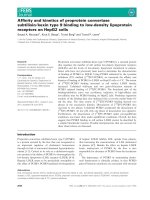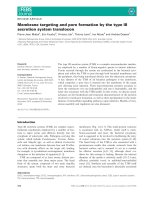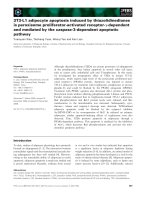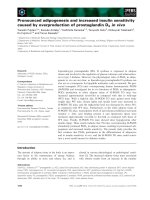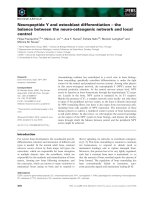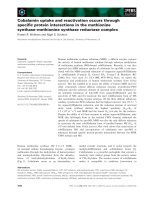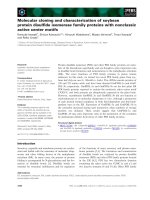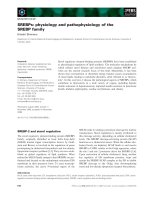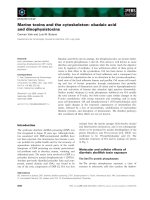Báo cáo khoa học: Halogenated benzimidazoles and benzotriazoles as inhibitors of the NTPase/helicase activities of hepatitis C and related viruses ppt
Bạn đang xem bản rút gọn của tài liệu. Xem và tải ngay bản đầy đủ của tài liệu tại đây (300.93 KB, 9 trang )
Halogenated benzimidazoles and benzotriazoles as inhibitors
of the NTPase/helicase activities of hepatitis C and related viruses
Peter Borowski
1
, Johanna Deinert
1
, Sarah Schalinski
1
, Maria Bretner
2
, Krzysztof Ginalski
3,4
,
Tadeusz Kulikowski
2
and David Shugar
2,4
1
Abteilung fur Virologie, Bernhard-Nocht-Institut fur Tropenmedizin, Hamburg, Germany;
2
Institute of Biochemistry & Biophysics,
Polish Academy of Sciences, Warsaw, Poland;
3
BioInfoBank, Poznan, Poland;
4
ICM, University of Warsaw, Poland
A search has been initiated for lead inhibitors of the non-
structural protein 3 (NS3)-associated NTPase/helicase
activities of hepatitis C virus, the related West Nile virus,
Japanese encephalitis virus and the human mitochondrial
Suv3 enzyme. Random screening of a broad range of unre-
lated low-molecular mass compounds, employing both
RNA and DNA substrates, revealed that 4,5,6,7-tetra-
bromobenzotriazole (TBBT) hitherto known as a potent
highly selective inhibitor of protein kinase 2, is a good
inhibitor of the helicase, but not NTPase, activity of hepa-
titis C virus NTPase/helicase. The IC
50
is approximately
20 l
M
with a DNA substrate, but only 60 l
M
with an RNA
substrate. Several related analogues of TBBT were enzyme-
and/or substrate-specific inhibitors. For example, 5,6-di-
chloro-1-(b-
D
-ribofuranosyl)benzotriazole (DRBT) was a
good, and selective, inhibitor of the West Nile virus enzyme
with an RNA substrate (IC
50
0.3 l
M
), but much weaker
with a DNA substrate (IC
50
3 l
M
). Preincubation of the
enzymes, but not substrates, with DRBT enhanced inhibi-
tory potency, e.g. the IC
50
vs the hepatitis C virus helicase
activity was reduced from 1.5 to 0.1 l
M
. No effect of pre-
incubation was noted with TBBT, suggesting a different
mode of interaction with the enzyme. The tetrachloro con-
gener of TBBT, 4,5,6,7,-tetrachlorobenzotriazole (TCBT; a
much weaker inhibitor of casein kinase 2) is also a much
weaker inhibitor than TBBT of all four helicases. Kinetic
studies, supplemented by comparison of ATP-binding sites,
indicated that, unlike the case with casein kinase 2, the mode
of action of the inhibitors vs the helicases is not by
interaction with the catalytic ATP-binding site, but rather by
occupation of an allosteric nucleoside/nucleotide binding
site. The halogeno benzimidazoles and benzotriazoles
included in this study are excellent lead compounds for the
development of more potent inhibitors of hepatitis C virus
and other viral NTPase/helicases.
Keywords: NTPase/helicases; hepatitis C and related viruses;
inhibitors; halogenated benzimidazoles/benzotriazoles.
Hepatitis C virus (HCV) infection, which results in chronic
or acute hepatitis, and may lead to liver cirrhosis and
hepatocellular carcinoma, is currently known to affect more
than 3% of the population worldwide. No vaccine has been
developed as yet, and current therapy, based on the use of
a-interferon, alone or in combination with the antiviral
agent ribavirin, is only moderately effective [1–4]. The
broad-spectrum antiviral ribavirin itself has recently been
shown to act as an RNA virus mutagen [5]. Surprisingly,
efforts to develop effective antiHCV agents have hitherto
been limited.
The HCV genome encodes a polyprotein, which is then
cleaved into 10 structural and nonstructural (NS) proteins.
One of these is the so-called NS3 protein, which exhibits
serine protease activity at the N-terminus, and helicase
and nucleotide triphosphatase (NTPase) activities at the
C-terminus [4,6]. The helicase activity of NS3, which plays a
key role in viral replication, appears to be an exceptionally
attractive target for termination of viral replication [7,8].
Computer-assisted sequence analysis of known and
putative NTPase/helicases has led to their classification as
three superfamilies (SF1, SF2 and SF3), and a smaller
group referred to as family 4 [9–11]. All four contain the
Walker A and B box sequences known to be involved in
NTP binding and hydrolysis [12]. Crystal structures of the
SF1 DNA NTPase/helicases from Escherichia coli and
Bacillus stearothermophilus, and of the SF2 HCV RNA
NTPase/helicase, have confirmed the functions of these
conserved motifs [13–16]. Blockage of the NTP-binding site
leads to inhibition of NTPase activity [17]. Binding studies
by Porter [18] have revealed two nucleotide-binding sites in
the HCV NTPase/helicase, the location and function of the
Correspondence to P. Borowski, Abteilung fur Virologie, Bernhard-
Nocht-Institut fur Tropenmedizin, D-20359 Hamburg, Germany.
Fax: +49 40 42818378, Tel.: +49 40 42818458,
E-mail: and D. Shugar, Institute of
Biochemistry & Biophysics, Polish Academy of Sciences,
5a Pawinskiego St., 02–106 Warsaw, Poland.
Fax/Tel.: +48 39 121623, E-mail:
Abbreviations: HCV, Hepatitis C virus; WNV, West Nile virus; JEV,
Japanese encephalitis virus; Suv3, mitochondrial human NTPase/
helicase; NS3, nonstructural protein 3; NTPase, nucleoside triphos-
phatase; CK2, casein kinase 2; DRB, 5,6-dichloro-1-(b-
D
-ribofuran-
osyl)benzimidazole; DBRB, 5,6-dibromo-1-(b-
D
-ribofuranosyl)
benzimidazole; DRBT, 5,6-dichloro-1-(b-
D
-ribofuranosyl)benzo-
triazole; a-DMRB, 5,6-dimethyl-1-(a-
D
-ribofuranosyl)benzimidazole;
TCBT, 4,5,6,7,-tetrachlorobenzotriazole; TBBT, 4,5,6,7-tetra-
bromobenzotriazole.
(Received 17 September 2002, revised 12 December 2002,
accepted 20 December 2002)
Eur. J. Biochem. 270, 1645–1653 (2003) Ó FEBS 2003 doi:10.1046/j.1432-1033.2003.03540.x
second being as yet unknown. However, there is accumu-
lating evidence that the NTPase and helicase activities of the
SF2 family enzymes may be modulated by occupation of
these putative nucleotide-binding sites. Ribavirin-5¢-triphos-
phate, a potent classical competitive inhibitor of the NTPase
activities of the West Nile virus (WNV) and HCV NTPase/
helicases at low ATP concentrations (<<K
m
), failed to
inhibit the ATPase activities at high ATP concentrations
(>K
m
) and, indeed, even stimulated enzyme activity. By
contrast, ribavirin-5¢-triphosphate moderately inhibits the
helicase activities of both enzymes by a mechanism that is
independent of the ATP concentration [19–21], most likely
due to occupation of the second nucleotide binding site.
Several attempts to develop HCV NTPase/helicase
inhibitors have been described. Two series of such com-
pounds, previously reported only in patents [22,23], are
composed of two benzimidazole, or aminophenylbenzimi-
dazole, moieties attached to symmetrical linkers of variable
lengths. These were reported to exhibit IC
50
values for
inhibition of the HCV helicase activity in the low micro-
molar range, subsequently confirmed and extended in a
Structure–Activity Relationship (SAR) study reported by
Phoon et al. [24]. Somewhat less effective are several
aminothiadiazoliums, again described only in patents [25].
During the course of random screening of a wide range
of unrelated compounds in a search for lead inhibitors of
HCV NTPase/helicase activities, it was noted that 4,5,6,7-
tetrabromobenzotriazole (TBBT), previously reported as
a highly selective inhibitor of protein kinase 2 (CK2)
[26,27], is a good inhibitor of the helicase activity, with an
IC
50
in the low micromolar range. We herein describe the
inhibitory properties of TBBT, and a number of related
benzotriazoles and benzimidazoles, at the NTPase/helicase
sites of HCV and the related viruses Japanese encephalitis
virus (JEV) and WNV, as well as the human NTPase/
helicase Suv3.
Materials and methods
Materials
DNA oligonucleotides were prepared by M. Schreiber
(Bernhard-Nocht-Institute, Hamburg, Germany). RNA
oligonucleotides were purchased from HHMI Biopoly-
mer/Keck Foundation, Biotechnology Resource Labora-
tory, Yale University School of Medicine (New Haven,
CT, USA). [c-
32
P]ATP (220 TbqÆmmol
)1
)and[c-
33
P]ATP
(110 TbqÆmmol
)1
) were from Hartman Analytic. All other
chemicals were obtained from Sigma.
Halogenated benzimidazole and benzotriazole nucleo-
sides were synthesized as described previously [27,28 and
references therein]. We are indebted to D. Vikic-Topic
(Ruder Boskovic Institute, Zagreb, Croatia) for the gift
of the nonhalogenated 5,6-dimethyl-1-(a-
D
-ribofuranosyl)
benzimidazole (a-DMRB), a key constituent of vitamin B
12
.
Synthesis of 4,5,6,7,-tetrachlorobenzotriazole (TCBT)
TCBT (4,5,6,7,-tetrachlorobenzotriazole) was synthesized
by chlorination of benzotriazole according to the modified
procedure of Wiley et al. [29]. The yield was 65%, with TLC
values of R
F
0.13 (CHCl
3
+ MeOH, 100 + 1), melting
point 254–256 °C, lit. [29] 256–260 °C, and UV values of
pH 2, k
max
273 nm (7900), 282 nm (8600), 299 nm (5900),
pH 6, k
max
290 nm (11 300), 296 nm (11 500), 308 nm
(6460); pH 12, k
max
290 nm (13 000), 296 nm (13 180),
308 nm (7670),
13
CNMR(d
6
dimethylsulfoxide), 137.508;
127.937; 118.841. Mass spectroscopy gave m/z (MH
+
),
257.9102; theoretical value for C
6
H
2
Cl
4
N
3
MH
+
, 257.917.
Synthesis of 4,5,6,7,-tetrabromobenzotriazole (TBBT)
TBBT was synthesized by modification of bromination
procedure described by Wiley et al. [29]. The yield was 60%,
with TLC values of R
F
0.16 (CHCl
3
+ MeOH, 100 + 1),
melting point 264–266 °C, lit. [29] 262–266 °C, and UV
values of MeOH, k
max
288 nm (9600), 300 nm (8670),
311 nm (6000), pH 2, k
max
279 nm (3400), 289 nm (3500),
303 nm (2800) pH 6–12, k
max
291 nm (10 800), 299 nm
(10 250), 310 nm (6670),
13
CNMR(d
6
dimethylsulfoxide),
143.002; 136.862; 124.637, 113.233; 107.122. Mass spectro-
scopy gave m/z (MH
+
), 435.872; theoretical value for
C
6
H
2
Br
4
N
3
MH
+
, 435.718.
Sources and purification of HCV, JEV, Suv3(D1-159)
and WNV NTPase/helicases
The NTPase/helicase domain of HCV NS3 was expressed in
E. coli and purified as described previously [30], with certain
modifications. The bacteria were collected by centrifugation
(5000 g for 1 h at 4 °C) and disrupted by sonication in lysis
buffer (100 m
M
Tris/HCl pH 7.5, 20% glycerol, 0.1%
Triton X-100, 200 m
M
NaCl, 1 m
M
b-mercaptoethanol,
2m
M
phenylmethylsulfonyl fluoride, 10 m
M
imidazole).
Insoluble material was pelleted at 26 000 g and the super-
natant mixed with 3 mL nickel-charged resin (Qiagen)
equilibrated with buffer containing 20 m
M
Tris/HCl
pH 7.5, 10% glycerol, 0.05% Triton X-100 and 1 m
M
b-mercaptoethanol) for 12 h. The matrix was transferred
to a column and washed with the foregoing buffer
supplemented with 200 m
M
NaCl and 20 m
M
imidazole.
Bound protein, eluted with 0.5
M
imidazole in the same
buffer, to a purity of 65–70%, was concentrated by
ultrafiltration on a 30-kDa membrane and fractionated on
a Superdex-200 column (Hi-Load; Amersham Pharmacia
Biotech) equilibrated with TGT buffer (20 m
M
Tris/HCl
pH 7.5, 10% glycerol, 0.05% Triton X-100, 1 m
M
EDTA,
1m
M
b-mercaptoethanol). Fractions containing most of the
ATPase and helicase activities ( 80%) were pooled and
used to investigate the enzyme properties.
The JEV NTPase/helicase was expressed in E. coli [31]
and purified according to the protocol for the HCV enzyme,
as above.
N-terminally truncated Suv3 NTPase/helicase,
Suv3(D1-159), was expressed in E. coli. A 1881-bp fragment
of the human Suv3 cDNA, coding for Suv3 protein
truncated 159 aa from the amino terminus, was amplified
by PCR using the following primers: forward, 5¢-CATGCC
ATGGCGCCATTTTTCTTGAGACATGCC-3¢; reverse,
5¢-CTGGGATCCGTCCGAATCAGGTTCCTTC-3¢
(purchased from Sigma), and the pKK plasmid as a
template [32]. The resulting fragment was cloned into NcoI
and BamHI sites of the pQE60 expression vector (Qiagen).
Sequences of both strands were verified, using an ABI Prism
1646 P. Borowski et al.(Eur. J. Biochem. 270) Ó FEBS 2003
377 DNA Sequencer. The His-tagged Suv3(D1–159) was
purified by the method described above for HCV NTPase/
helicase.
The final preparations of the enzymes were homogenous,
as demonstrated by Coomassie Blue staining of SDS/
polyacrylamide gels (Fig. 1, lanes 1,3,4).
The WNV NTPase/helicase was purified from the cell
culture medium of virus-infected Vero E6 cells as described
previously [20], with some modifications. Briefly, the
concentrated cell culture medium was mixed with 10 mL
Reactive Red120 agarose (Sigma) equilibrated with TGT
buffer for 4 h at 4 °C. The matrix was collected by
sedimentation, transferred to a column and washed with
TGT buffer. Bound protein was eluted with 1
M
KCl in the
same buffer, concentrated by ultrafiltration on a 30-kDa
membrane to a final volume of 2 mL, and subjected to gel
exclusion chromatography on a Superdex-200 column.
Fractions expressing ATPase and helicase activities were
chromatographed again on Reactive Red120 agarose
(5 mL) as described above. The salt-eluted protein was
precipitated with poly(ethylene glycol) (30%, w/w), collec-
ted by centrifugation (5000 g for 1 h at 4 °C) solubilized
with TGT buffer, and applied to a hydroxyapatite (HA-
Ultrogel) column preequilibrated with TGT buffer. The
column was washed with 10 mL TGT buffer, then with
2 mL TGT buffer containing 1
M
KCl, and again with 5 mL
TGT buffer. The NTPase/helicase was eluted with 1 mL
TGT buffer containing 50 m
M
KH
2
PO
4
, precipitated with
poly(ethylene glycol) and dissolved in TGT buffer. The
analysis of the final enzyme preparation by Coomassie blue-
stained SDS/PAGE revealed two proteins with molecular
masses of 66 and 60 kDa. N-terminal sequencing allowed
the identification of these proteins as BSA and WNV
NTPase/helicase (Fig. 1, lane 2) [20].
Protein concentrations of preparations of the NTPase/
helicases were determined by SDS/PAGE as described by
Hames and Rickwood [33]. Kinetic parameters were
determined by nonlinear-regression analysis using
ENZFIT-
TER
(BioSoft) and
SIGMA PLOT
(Jandel Corp.).
ATPase and helicase assays
ATPase activity of the NTPase/helicases was determined as
described previously [17,19,20]. Briefly, assays were per-
formedwith2pmolofWNV,0.5pmolofHCV,4pmolof
JEV or 0.2 pmol of Suv3(D1–159) NTPase/helicases. The
enzymes were incubated in a reaction mixture (final volume
25 lL) containing 20 m
M
Tris/HCl pH 7.5, 2 m
M
MgCl
2
,
1m
M
b-mercaptoethanol, 10% glycerol, 0.01% Triton X-
100, 0.1 mgÆmL
)1
BSA, 25 nCi [c-
33
P]ATP, and ATP
adjusted to concentrations corresponding to the K
m
values
determined for the ATPase reaction of each of the NTPase/
helicases. The reaction was conducted for 30 min at 30 °C
and terminated by addition of 0.5 mL activated charcoal
(2 mgÆmL
)1
). Following centrifugation at 10 000 g for
10 min, 100 lL aliquots of the supernatant were removed
and subjected to scintillation counting.
Helicase activity was tested with 2 pmol WNV, 0.5 pmol
HCV, 4 pmol JEV or 0.2 pmol of Suv3(D1–159) NTPase/
helicase. Unwinding of the partially hybridized DNA or
RNA substrate (4.7 p
M
of nucleotide base) was monitored
in a reaction mixture (final volume 25 lL) containing
20 m
M
Tris/HCl pH 7.5, 2 m
M
MgCl
2
,1m
M
b-mercapto-
ethanol, 10% glycerol, 0.01% Triton X-100, 0.1 mgÆmL
)1
BSA and ATP at concentrations indicated in the figure
legends. The reaction was conducted for 30 min at 30 °C
and stopped by addition of 5 lL termination buffer
(100 l
M
Tris/HCl pH 7.5, 20 m
M
EDTA, 0.5% SDS,
0.1% Triton X-100, 25% glycerol and 0.1% bromophenol
blue). Samples were fractionated on a 15% Tris/borate/
EDTA polyacrylamide gel containing 0.1% (w/w) SDS [20].
The gels were dried and exposed to Kodak X-ray films at
)70 °C. The areas of the gels corresponding to the released
strand and to the nonunwound substrate were cut out and
32
P radioactivity counted. Alternatively, the films were
scanned and the radioactivity associated with the released
strand and with the nonunwound substrate quantified with
GELIMAGE
software (Amersham Pharmacia Biotech).
Assays were carried out with the same level of enzyme
activity, as determined with the DNA substrate under
conditions described above.
Effect of preincubation of compounds with enzyme
on unwinding and hydrolysis efficacy
The selected enzyme was preincubated with a given
compound at 30 °Cin20lL of TGT buffer for various
periods of time and various concentrations of compound.
The unwinding reaction was then initiated by addition of
MgCl
2
, ATP, BSA and DNA or RNA substrate at
concentrations used in the standard helicase assay. ATP
hydrolysis was started by the addition of MgCl
2
, ATP and
BSA at concentrations used in the ATPase assay, in 10 lL
Fig. 1. SDS/PAGE analysis of the NTPase/helicases used in this study.
Aliquots of the final preparation of the HCV (1.2 lg protein, lane 1),
WNV (5.5 lg protein, lane 2), JEV (1.5 lg protein, lane 3), and
Suv3(D1–159) NTPase/helicases (1.0 lg protein, lane 4) were separated
by SDS/PAGE followed by staining with Coomassie blue. Molecular
mass markers are indicated on the left. Arrows indicate the locations of
the NTPase/helicases.
Ó FEBS 2003 Inhibition of NTPase/helicase activities of hepatitis C (Eur. J. Biochem. 270) 1647
TGT buffer. In control experiments, the NTPase/helicase
was preincubated alone under the same conditions.
Substrates for helicase reactions
The RNA substrate for the helicase assays consisted of
two partially hybridized oligonucleotides with sequences
as reported by Gallinari et al. [34]. The DNA substrate
was obtained by annealing two DNA oligonucleotides
synthesized with sequences corresponding to the deoxy-
nucleotide versions of the aforementioned RNA strands.
The release strands (26-mer) were 5¢-end labeled with
[c-
32
P]ATP, using T4 polynucleotide kinase (MBI, Fer-
mentas) as recommended by the manufacturer. For the
annealing reaction the labelled oligonucleotide was com-
bined at a molar ratio of 1 : 10 with the template strand
(40-mer), denatured for 5 min at 96 °C and slowly
renatured as described elsewhere [20]. The duplex DNA
was electrophoresed on a 15% native Tris/borate/EDTA
polyacrylamide gel, visualized by autoradiography and
extracted as described previously [20]. The amount of
DNA or RNA duplex used as substrate for the WNV
NTPase/helicase was determined by the ethidium bromide
fluorescent quantitation method [35].
Results
The DNA helicase activity of the HCV enzyme, monitored
under optimal conditions [20,21] in the presence of 105 l
M
ATP, corresponding to the K
m
for ATP in the ATPase
reaction, was followed in the presence of varying concen-
trations of the benzimidazole and benzotriazole analogues
(Fig. 2). The resulting IC
50
values for inhibition of helicase
activity, compared with the respective inhibitory parameters
of the phosphorylation reaction catalysed by CK2, are listed
in Table 1. The same results, shown in Fig. 3A, demon-
strate more clearly the potent inhibitory effects of DRBT
and TBBT, particularly the almost total inhibition of
activity by 10 l
M
of the former.
In the helicase assay, performed with the HCV NTPase/
helicase, changes in the ATP concentration over the range
0.1–1000 l
M
, and in the DNA substrate concentration in
the range 1.6–14.7 p
M
, did not detectably affect the
measured IC
50
values of the inhibitors. It may be concluded
that the inhibitors do not compete with ATP (see below).
However the concentration range of the DNA substrate was
necessarily too limited to draw any conclusion regarding the
mode of inhibition, because, as previously shown with the
WNV NTPase/helicase [20] strong substrate/product inhi-
bition of the unwinding reaction by the HCV enzyme was
observed when the DNA substrate concentration exceeded
15 p
M
(not shown).
The responses of the helicase activities of the other three
enzymes towards the various compounds, determined with
the DNA substrate, were monitored at ATP concentrations
corresponding to their respective K
m
values in the ATPase
reactions, that is 9.5 l
M
for WNV, 235 l
M
for JEV and
4.2 l
M
for Suv3(D1–159). Overall results for all four
Fig. 2. Structures of benzimidazole and benzotriazole derivatives.
Table 1. Inhibition by benzimidazoles and benzotriazoles of the helicase activities of the enzymes from HCV, WNV, JEV and Suv3(D1–159), with use
of a DNA substrate. Helicase activity was determined as a function of increasing concentrations of the compounds in the presence of ATP adjusted
to 9.5 l
M
, 105 l
M
, 235 l
M
and 4.2 l
M
for WNV, HCV, JEV and Suv3(D1–159) NTPase/helicases, respectively, and 4.7 pmol of DNA substrate
(concentration of nucleotide base) as described in Materials and methods. K
i
values for inhibition of protein kinase CK2 are from refs [26–28].
Inhibitor
IC
50
(l
M
) K
i
(l
M
)
HCV WNV JEV Suv3(D1–159) CKII
DBRB 320 >500 >500 >500 8
DRBT 1.5 3.0 >500 5.5 –
DRB 450 >500 >500 >500 24
a-DMRB 108 >500 >500 >500 –
TCBT 380 27 >500 >500 6
TBBT 20 1.7 200 50 0.6
1648 P. Borowski et al.(Eur. J. Biochem. 270) Ó FEBS 2003
NTPase/helicases are presented in Table 1. It should be
noted that DRBT (with a benzotriazole ring) is a micro-
molar inhibitor (IC
50
of 1.5–5.5 l
M
) of the helicase activities
of HCV, WNV and Suv3(D1–159), but not JEV.
The tetrachlorobenzotriazole TCBT is only a weak
inhibitor of the HCV enzyme, and a moderate inhibitor of
the WNV helicase activity, whereas the corresponding
tetrabromobenzotriazole TBBT is 20-fold more effective
against both these enzymes. Even in the case of the JEV and
Suv3(D1–159) enzymes, where TCBT is almost inactive, its
replacement by TBBT leads to measurable inhibition. It is
noteworthy that CK2 displayed a similar pattern of
response to TBBT and TCBT [27].
Somewhat unexpected was the finding that, using the
RNA substrate, the compounds examined (with the excep-
tion of TBBT) were much weaker inhibitors of the helicase
activities of the HCV, JEV and Suv3(D1–159) NTPase/
helicases (Table 2). A notable exception was the WNV
enzyme, for which all compounds, but not a-DMRB, were
comparable, or more effective (DRBT, DRB) inhibitors,
shown in the case of DRBT in Fig. 3C.
The two most effective inhibitors of the HCV helicase
activity, DRBT and TBBT (Table 1) differ significantly in
their mechanisms of action. Inhibition by DRBT was
dramatically increased when it was preincubated with the
enzyme in the absence of the DNA substrate. Preincubation
for 15, 30 and 45 min, followed by addition of the substrate,
ledtoIC
50
values of 1.1 l
M
, 0.45 l
M
and 0.1 l
M
, respect-
ively, and, after 60 min preincubation with the enzyme,
attained a plateau level at IC
50
¼ 0.09 l
M
(Fig. 4A). No
such effect of preincubation was observed with TBBT.
Furthermore, control experiments, in which DRBT was
preincubated with the DNA substrate, had no effect on the
IC
50
values.
The amino acid sequence of the N-terminal region of
Suv3(D1–159) NTPase/helicase is highly homologous to
domains I and II, but not III, of HCV NTPase/helicase.
Consequently, it is of interest that preincubation of
Suv3(D1–159) NTPase/helicase with DRBT, but not with
TBBT, led to a similar enhancement of inhibition as
observed with HCV NTPase/helicase (data not shown).
Attention was then directed to the effects of the various
analogues on the ATPase activity of the HCV enzyme,
monitored by release of
33
Pfrom[c-
33
P]ATP. At an ATP
concentration corresponding to its K
m
(105 l
M
), none of the
compounds, at concentrations up to 500 l
M
, exhibited
detectable inhibition (Fig. 3B). Even in the case of DRBT
an extensive preincubation with the enzyme did not lead to
Fig. 3. Inhibition of (A) helicase activity with a DNA substrate and (B)
ATPase activity of purified HCV NTPase/helicase by various concen-
trations of benzimidazole and benzotriazole analogues, added to the
reaction medium simultaneously with the enzyme. Unwinding and
hydrolytic activities in the absence of inhibitor were taken as 100%;
DRB (j), DBRB (d), DRBT (.), a-DMRB (m), TCBT (r), TBBT
(s). (C) Autoradigraphy demonstrating inhibition of purified WNV
NTPase/helicasebyDRBTwithanRNAsubstrate.Thereactionwas
conducted in the absence (lanes 1,2,7) or in the presence of DRBT at
0.3 l
M
(lane 3), 1.0 l
M
(lane 4), 3.0 l
M
(lane 5), 10 l
M
(lane 6), all
added to the reaction mixture simultaneously with enzyme. Lanes 1
and 7, the reaction mixture did not include enzyme and the substrate
was heat-denatured (lane 1) or native (lane 7). The reaction was
stopped by the addition of termination buffer, and substrate separated
from released product on a Tris/borate/EDTA polyacrylamide gel.
The dried gel was exposed to Kodak X-ray film at )70 °C for 12 h.
Ó FEBS 2003 Inhibition of NTPase/helicase activities of hepatitis C (Eur. J. Biochem. 270) 1649
noteworthy inhibition of the ATPase activity (Fig. 4B). This
was also the case when the ATP concentration was reduced
stepwise to as low as 10
)5
of its K
m
value. It clearly follows
that none of the inhibitors competes for the ATP-binding
site(s) of the NTPase.
Discussion
The NS3-associated helicase activity has long been consid-
ered an attractive target for development of effective drugs
against HCV and related flaviviruses, because of its key role
in viral replication [7,8,36]. Drugs targeting the unwinding
activity could act via one or more of the following
mechanisms [37]: (a) inhibition of ATPase activity by
interfering with ATP binding and therefore by limiting the
energy necessary for the unwinding, (b) inhibition of ATP
hydrolysis or release of ADP by blocking opening or closing
of domain 2, (c) inhibition of RNA (or DNA) substrate
binding, (d) inhibition of unwinding by sterically blocking
helicase translocation or (e) inhibition of coupling of ATP
hydrolysis to unwinding.
The present study describes several halogenated benzimi-
dazoles and benzotriazoles which inhibit the unwinding
reaction of three selected viral SF2 NTPase/helicases and,
albeit to a lesser extent, the SF1 human enzyme Suv3.
Inhibition is not accompanied by any change in ATPase
activity. Although the inhibitory effect appears to result
from direct interaction of the compounds with the enzymes,
some action at the level of the RNA and/or DNA substrates
cannot be unequivocally excluded. Various benzimidazole
analogues have been demonstrated to intercalate into
dsRNA and/or dsDNA structures [38–40], and may modify
their properties as substrates for NTPase/helicases, as is the
case with some imidazo[4,5-d]pyridazine derivatives [41].
Moreover, the interaction of these compounds with RNA
and/or DNA appears to be dependent on the base sequence
of the polynucleotide [42].
It is intriguing that the potent inhibitor of the HCV and
WNV NTPase/helicases, TBBT, is a specific ATP-competi-
tive inhibitor of protein kinase CK2, originally developed to
discriminate between protein kinases CK1 and CK2 [27],
and subsequently shown to exhibit striking selectivity
towards CK2 amongst more than 30 serine/threonine and
tyrosine protein kinases [26]. In the crystal structure of the
complex of the catalytic subunit of Zea mays CK2 with
TBBT [43], the latter is located in the CK2 active site
normally occupied by the purine moieties of the natural
substrates ATP and GTP, oriented roughly in the same
plane as the purine bases, and embedded deeply in the
hydrophobic pocket of CK2, fitting the protein cavity
almost perfectly (Fig. 5A). The protein–inhibitor inter-
actions are almost exclusively hydrophobic and, given the
bulkiness of the bromine atoms, these are primarily
responsible for the hydrophobic interactions with the apolar
chains of CK2. The only polar interaction, mediated by a
pair of hydrogen-bonded water molecules, involves the N(1)
of the TBBT triazole ring and two charged side-chains of the
protein [43]. TCBT, with the less bulky chlorine atoms, is a
much weaker inhibitor of CK2 [27].
Figure 5A demonstrates that, in the HCV NS3 NTPase/
helicase, ATP binds in the cleft between domains 1 and 2,
largely via interactions with motifs I (GxGKS/T) and II
(DexH) on domain 1. The relative location of ATP in the
Table 2. Inhibition by benzimidazoles and benzotriazoles of the helicase
activities of the enzymes from HCV, WNV, JEV and Suv3(D1–159),
with the use of an RNA substrate. Helicase activity was determined as
described in Table 1 with 4.7 pmol of RNA substrate (concentration
of nucleotide base).
Inhibitor
IC
50
(l
M
)
HCV WNV JEV Suv3(D1–159)
DBRB >500 245 >500 >500
DRBT >500 0.3 >500 >500
DRB >500 12 >500 >500
a-DMRB >500 >500 >500 >500
TCBT >500 15 >500 480
TBBT 60 0.9 250 200
Fig. 4. (A) Effect of preincubation for various time periods of HCV NTPase/helicase with DRBT on the inhibition of helicase activity with a DNA
substrate and (B) on inhibition of its ATPase activity. Aliquots of the enzyme were incubated in the presence of increasing concentrations of DRBT,
or in its absence, for 15 min (.), 30 min (d), 45 min (j), 60 min (m)and90min(r).
1650 P. Borowski et al.(Eur. J. Biochem. 270) Ó FEBS 2003
complex of the HCV NS3 NTPase/helicase with dU8
oligonucleotide (Protein Data Bank number 1A1V) [15] was
derived from the UvrB/ATP complex (Protein Data Bank
number 1D9Z) [44] following superposition of domains 1
and 1a of NS3 and UvrB, respectively. As revealed by the
Dali server [45], the structure of HCV NS3 NTPase/helicase
shares highest similarity with UvrB, a DNA helicase
adapted for nucleotide excision repair, and a member of
the same helicase II superfamily, in contrast to PcrA
helicase, which belongs to the helicase I superfamily [46].
Both structures, NTPase/helicase complexed with dU8, and
UvrB complexed with ATP, represent open forms of the
enzymes and, as revealed by the crystal structure of PcrA
helicase [16], additional interdomain (domain closure), and
intradomain and side-chain conformational changes, occur
upon binding of ATP and nucleic acid to ensure ATPase
activity.
Analysis of the mode of binding of ATP in the HCV
NTPase/helicase structure explains why TBBT is not an
ATP-competitive inhibitor. In the HCV NTPase/helicase,
ATP binds in a manner opposite to that in protein kinases,
with the adenine ring directed away from the cleft between
domains (Fig. 5). TBBT, as a specific inhibitor of CK2,
mimics the purine ring of ATP in the complex with CK2,
being deeply buried in the active site hydrophobic pocket
between the upper and lower domains. If it were an ATP-
competitive inhibitor of HCV NS3 NTPase/helicase, it
would occupy the position of the adenine ring in the opening
of the wide cleft between domains 1 and 2. Bearing in mind
that the inhibitory potency of TBBT depends largely on
complementarity of hydrophobic surfaces, this part of the
cleft is too large to allow for its tight binding, even after
domain closure. Moreover, closure of the cleft between
domains 1 and 2 is considered to be driven largely by
interactions of arginine residues from motif VI
(QRxGRxGR) in domain 2 with the phosphate groups of
ATP [15]. It appears highly unlikely that TBBT binding
could lead to such structural changes. Finally, surface
regions where the sugar and triphosphate moieties of ATP
bind are highly polar (data not shown). Consequently TBBT
must inhibit the helicase by one of the mechanisms (c–e)
referred to above. Attempts to understand the inhibitory
mechanism of TBBT at the atomic level, from the three-
dimensional structure of the NS3 NTPase/helicase, are
currently the subject of more detailed docking studies. The
mechanism of inhibition by DRBT appears to be somewhat
different and needs, in contrast to TBBT, more than 60 min
to develop full inhibitory activity. The cause of the slow
interaction with the enzyme remains unclear, but not
without precedence. Our previous observations with 5¢-O-
(4-fluorosulfonylbenzoyl)adenosine (FSBA) demonstrated
that this compound also requires 90–120 min for blockade,
accompanied by covalent binding to site(s) of WNV
NTPase/helicase [20].
Finally, attention should be drawn to the fact that
benzimidazoles and their nucleosides, including halogenated
analogues, have long been known as inhibitors of replica-
tion of various viruses. The earlier literature, extensively
reviewed by Tamm and Caliguri [47], has been updated by
Townsend et al. [48]. More recently reported inhibitors of
HCV (see Introduction) include bis-benzimidazole ana-
logues.
Particularly relevant are the 2,5,6-trihalogeno-1-b-
D
-ribo-
sylbenzimidazoles reported as potent and selective inhibitors
Fig. 5. Comparison of ATP binding in HCV NS3 helicase and protein kinase CK2. (A) Ribbon diagram of HCV NS3 helicase complexed with
MgATP and ssDNA. Conserved motifs involved in ATP binding, with motif I (phosphate-binding motif, or Walker motif A [12]), motif II
(Mg
2+
-binding motif, or Walker motif B) and motif VI shown in red. (B) Ribbon diagram of CK2 kinase catalytic subunit complexed with
MgATP. ATP-binding motifs, Gly-rich loop (Walker motif A) and DFG loop (Mg
2+
-binding motif comprising DWG sequence in CK2), are
shown in red. Mg
2+
ions are shown as white spheres.
Ó FEBS 2003 Inhibition of NTPase/helicase activities of hepatitis C (Eur. J. Biochem. 270) 1651
of human cytomegalovirus replication [49]. Unlike many
other antiviral nucleoside analogues, which require intra-
cellular phosphorylation for antiviral activity [50], these
compounds have been shown to act as such, and it has been
proposed that their mechanism of action is via inhibition of
the products of the human cytomegalovirus genes UL89
and UL56 [49]. It is, however, of some significance that the
same authors [48] had earlier noted that the heterocyclic
bases themselves, i.e. the 2,5,6-trihalogenobenzimidazoles,
are also good inhibitors, but were not further studied
because of their higher cytotoxicities in uninfected cells. It
appears to us that further studies on the inhibitory
properties of these bases should prove helpful in delineating
their mechanism of action, as well as those of their
nucleosides. It is conceivable that these bases, and/or their
nucleosides, may be NTPase/helicase inhibitors, bearing in
mind that herpes viruses possess two NTPase/helicases [51].
Acknowledgements
This research was supported by EC grants EMBEU No. ICA 1-CT-
2000-70010 and FP5 RTD No. QLRT-2001-01079.
References
1. McHutchison, J.G., Gordon, S.C., Schiff, E.R., Shiffman, M.L.,
Lee, W.M., Rustgi, V.K., Goodman, Z.D., Ling, M.H., Cort, S. &
Albrecht, J.K. (1998) Interferon a-2b alone or in combination
with ribavirin as initial treatment for chronic hepatitis C. Hepa-
titis Interventional Therapy Group. N.Engl.J.Med.339,
1485–1492.
2.Cummings,K.J.,Lee,S.M.,West,E.S.,Cid-Ruzafa,J.,Fein,
S.G., Aoki, Y., Sulkowski, M.S. & Goodman, S.N. (2001) Inter-
feron and ribavirin vs interferon alone in the re-treatment of
chronic hepatitis C previously nonresponsive to interferon: a meta-
analysis of randomized trials. JAMA 285, 193–199.
3. Tam, R.C., Lau, J.Y.N. & Hong, Z. (2002) Mechanisms of action
of ribavirin in antiviral therapies. Antiviral Chem. Chemother. 12,
261–272.
4. Wang, Q.M. & Heinz, B.A. (2000) Recent advances in prevention
and treatment of hepatitis C virus infections. Prog. Drug Res. 55,
1–32.
5. Crotty, S., Maag, D., Arnold, J.J., Zhong, W., Lau, J.Y.N., Hong,
Z., Andino, R. & Cameron, C.E. (2000) The broad-spectrum
antiviral ribonucleoside ribavirin is an RNA virus mutagen. Nat.
Med. 6, 1375–1379,.
6. Rosenberg, S. (2001) Recent advances in the molecular biology of
hepatitis C virus. J. Mol. Biol. 313, 451–464.
7. Matusan, A.E., Pryor, M.J., Davidson, A.D. & Wright, P.J.
(2001) Mutagenesis of the dengue virus type 2 NS3 protein within
and outside helicase motifs: Effects on enzyme activity and virus
replication. J. Virol. 75, 9633–9643.
8. Gu, B., Liu, C., Lin-Goerke, J., Malley, D.R., Gutshall, L.L.,
Feltenberger, C.A. & Del Vecchio, A.M. (2000) The RNA helicase
and nucleotide triphosphatase activities of the bovine viral diar-
rhea virus NS3 protein are essential for viral replication. J. Virol.
74, 1794–1800.
9. Gorbalenya, A.E. & Koonin. E.V. (1993) Helicases: Amino acid
sequence comparisons and structure-function relationships. Curr.
Opin. Struct. Biol. 3, 419–429.
10. Ilyina, T.V. & Koonin, E.V. (1992) Conserved sequence motifs in
the initiator proteins for rolling circle DNA replication encoded by
diverse replicons from eubacteria, eucaryotes and archaebacteria.
Nucleic Acids Res. 20, 3285.
11. Ilyina, T.V., Gorbalenya, A.E. & Koonin, E.V. (1992) Organiza-
tion and evolution of bacterial and bacteriophage primase-helicase
systems. J. Mol. Evol. 34, 351–357.
12. Walker, J.E., Saraste, M., Runswick, M.J. & Gay, N.J. (1982)
Distantly related sequences in the a-andb-subunits of ATP syn-
thase, myosin, kinases and other ATP-requiring enzymes and a
common nucleotide binding fold. EMBO J. 1, 945–951.
13. Korolev, S., Hsieh, J., Gauss, G.H., Lohman, T.M. & Waksman,
G. (1997) Major domain swiveling revealed by the crystal struc-
tures of complexes of E. coli Rep helicase bound to single stranded
DNA and ADP. Cell 90, 635–647.
14. Yao, N., Hesson, T., Cable, M., Hong, Z., Kwong, A., Le, H. &
Weber. P. (1997) Structure of the hepatitis C virus RNA helicase
domain. Nat. Struct. Biol. 4, 463–467.
15. Kim, J.L., Morgenstern, K., Griffith, J., Dwyer, M., Thomson, J.,
Murcko, M., Lin, C. & Caron. P. (1998) Hepatitis C virus NS3
RNA helicase domain with a bound oligonucleotide: the crystal
structure provides insights into the mode of unwinding. Structure
6, 89–100.
16. Velankar, S.S., Soultanas, P., Dillingham, M.S., Subramanya,
H.S. & Wigley, D.B. (1999) Crystal structures of complexes of
PcrA DNA helicase with a DNA substrate indicate an inchworm
mechanism. Cell 97, 75–84.
17. Borowski, P., Ku
¨
hl, R., Mueller, O., Hwang, L H., Schulze zur
Wiesch, J. & Schmitz, H. (1999) Biochemical properties of a
minimal functional domain with ATP-binding activity of the
NTPase/helicase of hepatitis C virus. Eur. J. Biochem. 266, 723.
18. Porter, D. (1998) Inhibition of the hepatitis C virus helicase-
associated ATPase activity by the combination of ADP, NaF,
MgCl2, and poly (rU). J. Biol. Chem. 273, 7390–7396.
19. Borowski, P., Mueller, O., Niebuhr, A., Kalitzky, M., Hwang,
L H., Schmitz, H., Siwecka, M.A. & Kulikowski, T. (2000) ATP
binding domain of NTPase/helicase as target for hepatitis C
antiviral therapy. Acta Biochim. Polon. 47, 173–180.
20. Borowski, P., Niebuhr, A., Mueller, O., Bretner, M., Felczak, K.,
Kulikowski, T. & Schmitz, H. (2001) Purification and character-
ization of West Nile virus nucleoside triphosphatase (NTPase)/
helicase: evidence for dissociation of the NTPase and helicase
activities of the enzyme. J. Virol. 75, 3220–3229.
21. Borowski, P., Lang, M., Niebuhr, A., Haag, A., Schmitz, H.,
Schulze zur Wiesch, J., Choe, J., Siwecka, M.A. & Kulikowski, T.
(2001) Inhibition of the helicase activity of HCV NTPase/helicase
by 1-b-
D
-ribofuranosyl-1,2,4-triazole-3 carboxamide-5¢-triphos-
phate (ribavirin-TP). Acta Biochim. Polon. 48, 739–744.
22. Diana, G.D. & Bailey, T.R. (1997) Patent. US5633388.
23. Diana, G.D., Bailey, T.R. & Nitz, T.J. (1997) Patent. WO9736554.
24. Phoon, C.W., Ng, P.Y., Tong, A.E., Yeo, S.L. & Sim, M.M.
(2001) Biological evaluation of hepatitis C virus helicase inhibitors.
Bioorg.Med.Chem.Lett.11, 1647–1650.
25. Janetka, J.W., Ledford, B.E. & Mullican, M.D. (2000) Patent.
WO0024725.
26. Sarno, S., Reddy, H., Meggio, F., Ruzzene, M., Davies, S.P.,
Donella-Deana, A., Shugar, D. & Pinna, L.A. (2001) Selectivity
of 4,5,6,7-tetrabromobenzotriazole, an ATP site-directed inhibitor
of protein kinase CK2 (Ôcasein kinase-2Õ). FEBS Lett. 496, 44–48.
27. Szyszka, R., Grankowski, N., Felczak, K. & Shugar, D. (1995)
Halogenated benzimidazoles and benzotriazoles as selective
inhibitors of protein kinases CK I and CK II from Saccharomyces
cerevisiae and other sources. Biochem. Bioophys. Res. Commun.
208, 418–424.
28. Dobrowolska, G., Muszynska, G. & Shugar, D. (1991) Benzimi-
dazole nucleoside analogues as inhibitors of plant (maize seedling)
casein kinases. Biochim. Biophys. Acta. 1080, 226.
29. Wiley, R.H. & Hussung, K.F. (1957) Halogenated benzotriazoles.
J. Am. Chem. Soc. 79, 4395–4400.
1652 P. Borowski et al.(Eur. J. Biochem. 270) Ó FEBS 2003
30. Gwack, Y., Kim, D.W., Han, J.H. & Choe. J. (1996) Characteri-
zation of RNA binding activity and RNA helicase activity of the
hepatitis C virus NS3 protein. Biochem. Biophys. Res. Commun.
255, 654–659.
31. Chang, Y.S., Liao, C.L., Tsao, C.H., Chen, M.C., Liu, C.I., Chen,
L.K. & Lin, Y.L. (1999) Membrane permeabilization by small
hydrophobic nonstructural proteins of Japanese encephalitis virus.
J. Virol. 73, 6257–6264.
32. Dmochowska, A., Kalita, K., Krawczyk, M., Golik, P., Mroczek,
K., Lazowska, J., Stepien, P.P. & Bartnik, E. (1999) A human
putative Suv3-like RNA helicase is conserved between Rhodo-
bacter and all eukaryotes. Acta Biochim. Pol. 46, 155–162.
33. Hames, B.D. & Rickwood, D. (1990) Gel Electrophoresis of Pro-
teins: a Practical Approach, 2nd edn. Oxford University Press,
Oxford, New York, Tokyo.
34. Gallinari, P., Brennan, D., Nardi, C., Brunetti, M., Tomei, L.,
Steinku
¨
hler, C. & De Francesco. R. (1998) Multiple enzymatic
activities associated with recombinant NS3 of hepatitis C virus.
J. Virol. 72, 6758–6769.
35. Sambrook, J., Fritsch, F. & Maniatis, T. (1989) Molecular Clon-
ing: a Laboratory Manual, 2nd edn. Cold Spring. Harbor
Laboratory Press, Cold Spring Harbor, New York.
36. Blight, K.J., Kolykhalov, A.A., Reed, K.E., Agapov, E.V. &
Rice, C.M. (1998) Molecular virology of hepatitis C virus: an
update with respect to potential antiviral targets. Antivir. Ther. 3,
71–81.
37. Yao, N. & Weber, P.C. (1998) Helicase, a target for novel
inhibitors of hepatitis C virus. Antivir. Ther. 3, 93–97.
38. Kubota, Y., Iwamoto, T. & Seki, T. (1999) The interaction of
benzimidazole compounds with DNA: intercalation and groove
binding modes. Nucleic Acids Symp Ser. 42, 53–54.
39. Wood, A.A., Nunn, C.M., Czarny, A., Boykin, D.W. & Neidle, S.
(1995) Variability in DNA minor groove width recognised by
ligand binding: the crystal structure of a bis-benzimidazole com-
pound bound to the DNA duplex d (CGCGAATTCGCG) 2.
Nucleic Acids Res. 23, 3678–3684.
40. Sapse, A.M., Sapse, D., Jain, D.C. & Lown, J.W. (1995)
Quantum chemical studies employing an ab initio combination
approach on the binding of the bis-benzimidazole Hoechst
33258 to the minor groove of DNA. J. Biomol. Struct Dyn. 12,
857–868.
41. Borowski, P., Lang, M., Haag, A., Schmitz, H., Choe, J., Chen,
H.M. & Hosmane, R.S. (2002) Characterization of imidazo[4,5-d]
pyridazine nucleosides as modulators of unwinding reaction
mediated by West Nile virus nucleoside triphosphatase/helicase:
evidence for activity on the level of substrate and/or enzyme.
Antimicrob. Agents Chemother. 46, 1231–1239.
42. Marsch, G., Ward, R.L., Colvin, M. & Turteltaub, K.W. (1994)
Non-covalent DNA groove-binding by 2-amino-1-methyl-6
phenylimidazo[4,5-b]pyridine. Nucleic Acids Res. 22, 5415.
43. Battistutta, R., De Moliner, E., Sarno, S., Zanotti, G. & Pinna,
L.A. (2001) Structural features underlying selective inhibition of
protein kinase CK2 by ATP site-directed tetrabromo-2-benzo-
triazole. Protein Sci. 10, 2200–2206.
44. Theis, K., Chen, P.J., Skorvaga, M., Van Houten, B. & Kisker, C.
(1999) Crystal structure of UvrB, a DNA helicase adapted for
nucleotide excision repair. EMBO J. 18, 6899–6907.
45. Holm, L. & Sander, C. (1995) Dali: a network tool for protein
structure comparison. Trends Biochem. Sci. 20, 478–480.
46. Gorbalenya, A.E., Koonin, E.V., Donchenko, A.P. & Blinov,
V.M. (1989) Two related superfamilies of putative helicases
involved in replication, recombination, repair and expression of
DNA and RNA genomes. Nucleic Acids Res. 17, 4713–4730.
47. Tamm, I. & Caliguri, L. (1972) 2-(a-Hydroxybenzyl)benzimidazole
and Related Compounds. In Chemotherapy of Virus Diseases
(Bauer, D.J., ed.), pp, 115–179. Pergamon Press, Oxford, UK.
48. Townsend, L.B., Devivar, R.V., Turk, S.R., Nassiri, M.R. &
Drach, J.C. (1995) Design, synthesis, and antiviral activity of
certain 2,5,6-trihalo-1-(beta-
D
-ribofuranosyl) benzimidazoles.
J. Med. Chem. 38, 4098–4105.
49. Krosky, P.M., Borysko, K.Z., Nassiri. M.R., Devivar, R.V., Ptak,
R.G., Davis, M.G., Biron, K.K., Townsend, L.B. & Drach, J.C.
(2002) Phosphorylation of beta-
D
-ribosylbenzimidazoles is not
required for activity against human cytomegalovirus. Antimicrob.
Agents Chemother. 46, 478–486.
50. Shugar, D. (1999) Viral and host-cell protein kinases: enticing
antiviral targets and relevance of nucleoside, and viral thymidine,
kinases. Pharmacol. Ther. 82, 315–335.
51. Marintcheva, B. & Weller, S.K. (2001) A tale of two HSV-1
helicases: roles of phage and animal virus helicases in DNA
replication and recombination. Prog. Nucleic Acid Res. Mol. Biol.
70, 77–118.
Ó FEBS 2003 Inhibition of NTPase/helicase activities of hepatitis C (Eur. J. Biochem. 270) 1653
